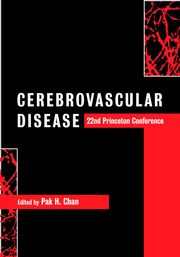Book contents
- Frontmatter
- Contents
- List of contributors
- Preface
- Acknowledgments
- Part I Special lectures
- Part II Oxidative stress
- Part III Apoptosis
- Part IV Hot topics
- Part V Hemorrhage, edema and secondary injury
- Part VI Inflammation
- Part VII Gene transfer and therapy
- 22 Adenoviral vectors for gene therapy in stroke
- 23 Gene transfer of glial cell line-derived neurotrophic factor prevents ischemic brain injury
- 24 Vasomotor effects of nitric oxide, superoxide dismutases and calcitonin gene-related peptide
- Part VIII Neurogenesis and plasticity
- Part IX Magnetic resonance imaging in clinical stroke
- Part X Risk factors, clinical trials and new therapeutic horizons
- Index
- Plate section
24 - Vasomotor effects of nitric oxide, superoxide dismutases and calcitonin gene-related peptide
from Part VII - Gene transfer and therapy
Published online by Cambridge University Press: 02 November 2009
- Frontmatter
- Contents
- List of contributors
- Preface
- Acknowledgments
- Part I Special lectures
- Part II Oxidative stress
- Part III Apoptosis
- Part IV Hot topics
- Part V Hemorrhage, edema and secondary injury
- Part VI Inflammation
- Part VII Gene transfer and therapy
- 22 Adenoviral vectors for gene therapy in stroke
- 23 Gene transfer of glial cell line-derived neurotrophic factor prevents ischemic brain injury
- 24 Vasomotor effects of nitric oxide, superoxide dismutases and calcitonin gene-related peptide
- Part VIII Neurogenesis and plasticity
- Part IX Magnetic resonance imaging in clinical stroke
- Part X Risk factors, clinical trials and new therapeutic horizons
- Index
- Plate section
Summary
Introduction
Several years ago we wrote “after several years of unfettered excitement and hype it is now clear that gene therapy is at a very early stage of development”. That statement, although quite conservative, still seems appropriate.
We remain optimistic, however, about the long-term potential value of gene transfer to cerebral blood vessels. The method has already led to novel insights into vascular biology, and it is likely that gene therapy will ultimately prove to be useful in prevention and treatment of some types of stroke.
In this review, we will first describe several applications of gene transfer to blood vessels that have led to new insights in vascular biology. Second, we will describe a new method to study the cerebral circulation, which involves gene transfer of different isoforms of superoxide dismutase (SOD). Then we will describe studies that suggest that gene therapy may eventually prove to be useful in prevention of cerebral vasospasm after subarachnoid hemorrhage (SAH).
Approaches to gene transfer
We use a replication-deficient recombinant adenovirus to transfer DNA to the nucleus of target cells, which results in transcription of mRNA and translation of the desired protein. We have made most of the recombinant viruses that we use in experiments, by deletion of the portions of the viral genome that are required for replication and then insertion of the gene of interest into the region that has been deleted.
- Type
- Chapter
- Information
- Cerebrovascular Disease22nd Princeton Conference, pp. 284 - 296Publisher: Cambridge University PressPrint publication year: 2002



